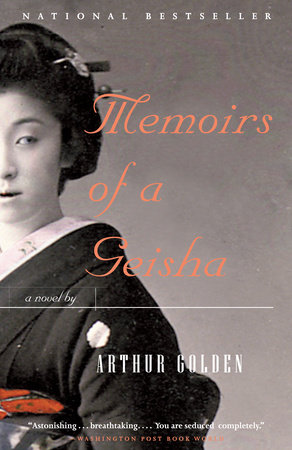Memoirs of a Geisha Reader’s Guide
By Arthur Golden


1. Many people in the West think of geisha simply as prostitutes. After reading Memoirs of a Geisha, do you see the geisha of Gion as prostitutes? What are the similarities, and what are the differences? What is the difference between being a prostitute and being a "kept woman," as Sayuri puts it [p. 291]?
2. "The afternoon when I met Mr. Tanaka Ichiro," says Sayuri, "really was the best and the worst of my life" [p. 7]. Is Mr. Tanaka purely motivated by the money he will make from selling Chiyo to Mrs. Nitta, or is he also thinking of Chiyo’s future? Is he, as he implies in his letter, her friend?
3. In his letter to Chiyo, Mr. Tanaka says "The training of a geisha is an arduous path. However, this humble person is filled with admiration for those who are able to recast their suffering and become great artists" [p. 103]. The word "geisha" in fact derives from the Japanese word for art. In what does the geisha’s art consist? How many different types of art does she practice?
4. Does Sayuri have a better life as a geisha than one assumes she would have had in her village? How does one define a "better" life? Pumpkin, when offered the opportunity to run away, declines [p. 53]; she feels she will be safer in Gion. Is her decision wise?
5. How does Sayuri’s status at the Nitta okiya resemble, or differ from, that of a slave? Is she in fact a slave?
6. Are Mother and Granny cruel by nature, or has the relentless life of Gion made them what they are? If so, why is Auntie somewhat more human? Does Auntie feel real affection for Sayuri and Pumpkin, or does she see them simply as chattel?
7. "We must use whatever methods we can to understand the movement of the universe around us and time our actions so that we are not fighting the currents, but moving with them" [p. 127]. How does this attitude differ from the Western notion of seizing control of one’s destiny? Which is the more valid? What are Sayuri’s feelings and beliefs about "free will"?
8. Do you see Sayuri as victimized by Nobu’s attentions, or do you feel pity for Nobu in his hopeless passion for Sayuri? Do you feel that, in finally showing her physical scorn for Nobu, Sayuri betrayed a friend, or that real friendship is impossible between a man and a woman of their respective stations?
9. How do Japanese ideas about eroticism and sexuality differ from Western ones? Does the Japanese ideal of femininity differ from ours? Which parts of the female body are fetishized in Japan, which in the West? The geisha’s ritual of preparing herself for the teahouse is a very elaborate affair; how essentially does it differ from a Western women’s preparation for a date?
10. Does the way in which the Kyoto men view geisha differ from the way they might view other women, women whom they might marry? What are the differences? How, in turn, do geisha view men? Is the geisha’s view of men significantly different from that of ordinary women?
11. Do you find that the relationship between a geisha and her danna is very different from that between a Western man and his mistress? What has led Sayuri to think that "a geisha who expects understanding from her danna is like a mouse expecting sympathy from a snake" [p. 394]?
12. As the older Sayuri narrates her story, it almost seems as though she presents Chiyo and Sayuri as two different people. In what ways are Chiyo and Sayuri different? In what ways are they recognizably the same person?
13. Pumpkin believes that Sayuri betrayed her when she, rather than Pumpkin, was adopted by the Nitta okiya. Do you believe that Sayuri was entirely blameless in this incident? Might she have helped to make Pumpkin’s life easier while they were in the okiya together? Or has Pumpkin’s character simply been corrupted by her years with Hatsumomo and the entire cruel system that has exploited her?
14. Sayuri senses that she shares an en, a lifelong karmic bond, with Nobu [p. 295]. How might a Western woman express this same idea?
15. During Sayuri’s life, Japan goes through a series of traumas and unprecedented cultural change: the Great Depression, the War, the American Occupation. How do the inhabitants of Gion view political events in the outside world? How much effect do such events have upon their lives? How aware are they of mainstream Japanese culture and life?
16. What personal qualities do Sayuri and Mameha have that make them able to survive and even prosper in spite of the many cruelties they have suffered? Why is Hatsumomo, for example, ultimately unable to survive in Gion?
17. Is Sayuri the victim of a cruel and repressive system, a woman who can only survive by submitting to men? Or is she a tough, resourceful person who has not only survived but built a good life for herself with independence and even a certain amount of power?
18. Why might Golden have chosen to begin his narrative with a "Translator’s Note"? What does this device accomplish for him?
19. In Memoirs of a Geisha, Arthur Golden has done a very daring thing: he, an American man, has written in the voice of a Japanese woman. How successfully does he disguise his own voice? While reading the novel, did you feel that you were hearing the genuine voice of a woman?